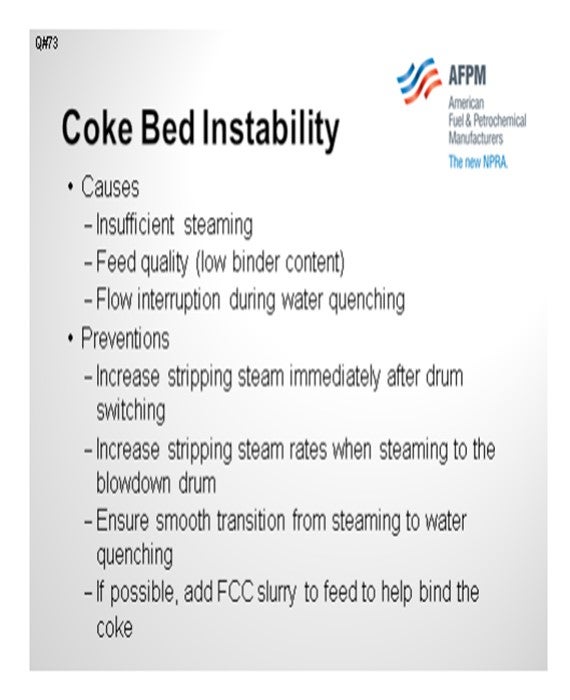Question 73: What is your experience with coke bed instability?
BASHAM (Marathon Petroleum Corporation)
We have seen coke beds collapse during the beginning stages of the quench water addition. We have had operational problems because we were not able to get the quench water into the coke bed. We even tried alternating back and forth between the stripping steam and the quench water, but we were not able to penetrate the coke bed with the quench water. The only option that we had at that point was to quench the coke bed using the top water quench. That usually takes a lot longer. In most designs, if you have a top water quench, it is smaller piping. It has been an issue that we have seen if there have been different types of crudes and highly paraffinic crudes are being mixed with asphaltenic crudes. In fact, that is the only time that we really saw this type of coke bed instability.
Some of the causes, as I mentioned, are the feed quality and if you have a low binder content, insufficient steaming, or if you interrupt flow during the water quench step. As far as preventions, we tried to increase the stripping steam immediately at drum swap. You can also increase the stripping steam rates when you are steaming to the blowdown drum. If you are steaming into the fractionator, you have to be careful not to overwhelm your overhead cooling capabilities. You want to try to ensure a smooth transition from your stripping steam step to the water quenching. If it is possible, you can add a small amount of FCC slurry to help bind the coke.

BASHAM (Marathon Petroleum Corporation)
We have seen instances where the coke bed collapsed during the beginning stages of the water quench step. The collapsed coke blocks the bottom drum feed piping and prevents quench water from flowing up through the coke bed. We have tried to alternate steam and water flows to unblock the feed piping, but this has proven to be unsuccessful. Our only option to quench the drum has been to use the top water quench piping and carefully quench the coke bed from the top down.
These are several reasons for coke bed instability, including:
1. Insufficient steaming of the coke bed after switching feed to another drum,
2. Feedstocks that produce a soft coke having low binder content, and
3. Flow interruption during the water quench step.
Practices to try to minimize coke bed stability are as follows:
1. Increase stripping steam immediately after the drum switch to help clear the feed line and ensure channels in the coke bed are open. Be mindful of fractionator overhead cooling limitations and watch for any coke bed lifting.
2. Increase stripping steam rates when steaming to the blowdown drum.
3. Ensure a smooth transition from stripping steam to quench water addition. Stopping the flow of steam or water can result in collapsing the coke bed channels.
4. Adding a small percentage of FCC slurry to the feed can help bind shot coke and reduce hot spots by improving coke bed permeability.
TRAN (Houston Refining, LP)
We have experienced coke fallouts after removing the drum bottom head and also coke bed cave-ins while drilling. Typically, we adjust the coker heater outlet temperature to shift coke morphology. Fluid catalytic cracking light cycle oil and heavy cycle oil can also be injected in the feed to bind the loose shot coke. We have installed automatic bottom unheading devices to eliminate exposure of the operator when the coke drum bottom head is removed. When the drill bit is stuck due to bed cave-in, we fill the coke drum with water and float the drill bit out of the collapsed coke bed.
LEE (BP Products North America)
Some cokers have reported some coke bed instability at the top of the coke bed (top of the bed shifting or fluffing up). Our experience has been that this is due to having too low a coking temperature. Increasing temperature has been helpful in addressing this issue, sometimes for the full coking cycle and sometimes for the final few hours of the coking cycle. Inadequately drained drums can also cause coke fall out. Relatively soft coke produced from paraffinic resid can cave in during drilling, soft coke produced due to low drum temperatures can cave in during drilling, and loose shot coke will flow out of the coke drum when the bottom head is removed. There is lots of experience with many different potential causes.